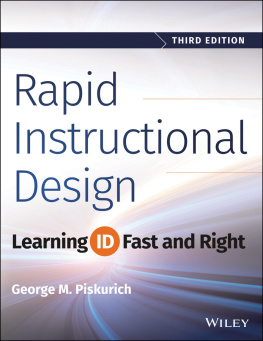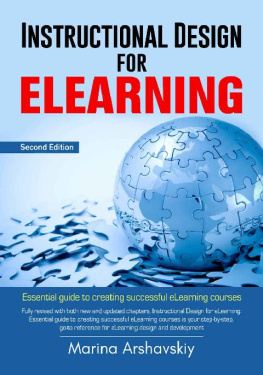
Cover image: Abstract Speed Motion iStock.com/nadia
Cover design: Wiley
This book is printed on acid-free paper.
Copyright 2015 by John Wiley & Sons, Inc. All rights reserved
Published by John Wiley & Sons, Inc., Hoboken, New Jersey
Published simultaneously in Canada
No part of this publication may be reproduced, stored in a retrieval system, or transmitted in any form or by any means, electronic, mechanical, photocopying, recording, scanning, or otherwise, except as permitted under Section 107 or 108 of the 1976 United States Copyright Act, without either the prior written permission of the Publisher, or authorization through payment of the appropriate per-copy fee to the Copyright Clearance Center, 222 Rosewood Drive, Danvers, MA 01923, (978) 750-8400, fax (978) 646-8600, or on the web at www.copyright.com. Requests to the Publisher for permission should be addressed to the Permissions Department, John Wiley & Sons, Inc., 111 River Street, Hoboken, NJ 07030, (201) 748-6011, fax (201) 748-6008, or online at www.wiley.com/go/permissions.
Limit of Liability/Disclaimer of Warranty: While the publisher and author have used their best efforts in preparing this book, they make no representations or warranties with the respect to the accuracy or completeness of the contents of this book and specifically disclaim any implied warranties of merchantability or fitness for a particular purpose. No warranty may be created or extended by sales representatives or written sales materials. The advice and strategies contained herein may not be suitable for your situation. You should consult with a professional where appropriate. Neither the publisher nor the author shall be liable for damages arising herefrom.
For general information about our other products and services, please contact our Customer Care Department within the United States at (800) 762-2974, outside the United States at (317) 572-3993 or fax (317) 572-4002.
Wiley publishes in a variety of print and electronic formats and by print-on-demand. Some material included with standard print versions of this book may not be included in e-books or in print-on-demand. If this book refers to media such as a CD or DVD that is not included in the version you purchased, you may download this material at http://booksupport.wiley.com. For more information about Wiley products, visit www.wiley.com.
Library of Congress Cataloging-in-Publication Data is on file.
978-1-118-97397-4 (pbk.)
978-1-118-97414-8 (ebk.)
978-1-118-97413-1 (ebk.)
Tool List
Chapter 1
Chapter 2
Chapter 3
Chapter 4
Chapter 5
Chapter 6
Chapter 7
Chapter 8
Chapter 9
Chapter 10
Preface for the Third Edition
I find it kind of hard to believe that the first edition of this book came out in 2000, and the second edition in 2006. In those fourteen years, and even in the last six, so much has changed in the field of instructional design. Delivery systems that were the gold standard when the first edition was published have almost disappeared, others that were barely on the cutting edge are now not just normal everyday deliveries, but required knowledge for instructional design (ID), and still others that weren't even a ghost of a whisper when the second edition came out are now mainstream enough to be at least a possibility in the ID tool kit.
Yet, even with all these changes, the basics of instructional design remain. ISD and ADDIE have been challenged more times than I can count in those fourteen years by various methodologies and their associated acronyms that have appeared, flourished for a time, then died away as designers went back to what they knew worked. Today we have AGILE and SAM, both of which have very strong and useful conceptualizations going for them, but that are, in the end, based on the tried-and-true ISD concepts of analysis, design, development, implementation, and evaluation.
That being said, why a third edition of this book? Well, first, those prickly new delivery systems need to be addressed. They range from the somewhat simple concept of flipped classrooms to the mysteries of the Cloud and what it means to the designer. In between is the philosophical concept of social network based learning, and how you use it, control it (if that's possible, and if you really want to) and how to design for it. So this edition will discuss these concepts as they affect the designer, at least as much as we can, considering that they are so new that there hasn't been all that much practical application done with them yet.
Second, some of the templates and figures needed a bit of revision, as time and the discipline have passed them by. I'm afraid I went a bit overboard on this, as you'll find over twenty-five new templates, checklists, and figures in this edition, ranging from a checklist on how to design a field trip to a new blended learning evaluation instrument.
And finally, there was a need to correct some mistakes (as those who have been using the first and second editions have been telling me) and rectify some omissions, such as planning for communicating and marketing programs, and the important task of training facilitators to facilitate.
We also took the instructor's guide out and put it online, so the book is not quite as hefty (although it won't be as good a doorstop) and to make it easy for you to download and use the templates and such.
So here's hoping this edition continues the purpose of the previous two in helping to make you a better instructional designer, and doing that more effectively and efficiently, as any good instructional design should.
George
Introduction
PURPOSE
The purpose of this book is to consider how to make both the learning and doing of instructional design faster. Proper instructional design is an absolutely critical, but very time-consuming, aspect of any training process, so finding techniques to do it rightbut rapidlyis important, and the benefits of employing these techniques are pretty obvious.
This book covers all the basics of instructional design, from analysis to evaluation, and perhaps just a little more, but does so without the theory, with plenty of practical checklists, and with many hints on how to design better and more quickly in this age of technology-based training.
Some might say that in dealing with basic instructional design this book is treading on much furrowed ground. Although this might be the case, we will be using a somewhat different type of plow; and perhaps it is time to revisit that ground, particularly from a new perspective.
At a recent international training conference exposition, I took a tour of the various publishers' booths and asked for books on instructional design. There weren't many to choose from, and most of the ones I did find were based on this or that new theory of learning. It seems that the most utilized and recommended basic instructional design book is still Dick and Carey's (1990) The Systematic Design of Instruction, which, even in its third edition, is ten years old.
By no means am I suggesting that this book should or will replace Dick and Carey; the focus, audience, and tone are all very different. However, the intent is pretty much the same: to discuss the most effective methods for designing instruction, albeit in this case, how to design more rapidly.
Instructional design is a difficult topic to write about at best. It seems that no matter what you say or how you say it you'll miss the mark for someone. You'll be too theoretical for some, yet not theoretical enough for others; too simplistic in your explanations or not basic enough; too focused on the needs of the new designer, or the needs of experienced practitioners; and what about the sometimes designer; and so on.
Next page








